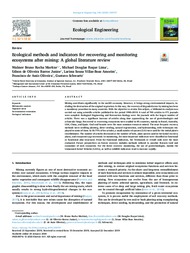Ecological methods and indicators for recovering and monitoring ecosystems after mining: A global literature review.
Ecological methods and indicators for recovering and monitoring ecosystems after mining: A global literature review.
Author(s): MARTINS, W. B. R.; LIMA, M. D. R.; BARROS JUNIOR, U. O.; AMORIM, L. S. V.-B.; OLIVEIRA, F. de A.; SCHWARTZ, G.
Summary: Mining contributes significantly to the world's economy. However, it brings strong environmental impacts, including the destruction of the original vegetation. In this way, the recovery of degraded areas by mining has been a mandatory procedure in many countries. With the objective to review this subject, a bibliometric analysis was carried out using scientific articles published in the period 1990?2018. A total of 700 articles in 171 journals were sampled. Ecological Engineering and Restoration Ecology were the journals with the largest number of articles. There was a significant increase of articles along time approaching the use of geotechnologies and arbuscular fungi. Recovered or recovering ecosystems were studied in 45 countries, mainly in Brazil, Australia, USA, China, and Spain. Coal and bauxite were the most common resources mined. The most frequent recovery methods were: seedling planting, direct seeding, natural regeneration, and hydroseeding, with techniques employed in some of them. In 35.71% of the articles, a small number of species (2?5) were used for the initial plant's establishment. The number of articles decreased as the number of both, plant species used in the initial recovery phase, and ecosystem's age increased. In monitoring, the most important indicators were classified as functional or functional plus structural. From the functional indicators, the Technosols or rebuilt soils were the most evaluated. Future perspectives on forests recovery includes methods tailored to peculiar features (soil and economic) of each ecosystem. For the forest recovery monitoring, the use of geotechnologies, mainly the Unmanned Aerial Vehicles (UAVs), as well as wildlife indicators tend to increase rapidly.
Publication year: 2020
Types of publication: Journal article
Unit: Embrapa Eastern Amazon
Observation
Some of Embrapa's publications are published as ePub files. To read them, use or download one of the following free software options to your computer or mobile device. Android: Google Play Books; IOS: iBooks; Windows and Linux: Calibre.
Access other publications
Access the Agricultural Research Database (BDPA) to consult Embrapa's full library collection and records.
Visit Embrapa Bookstore to purchase books and other publications sold by Embrapa.

